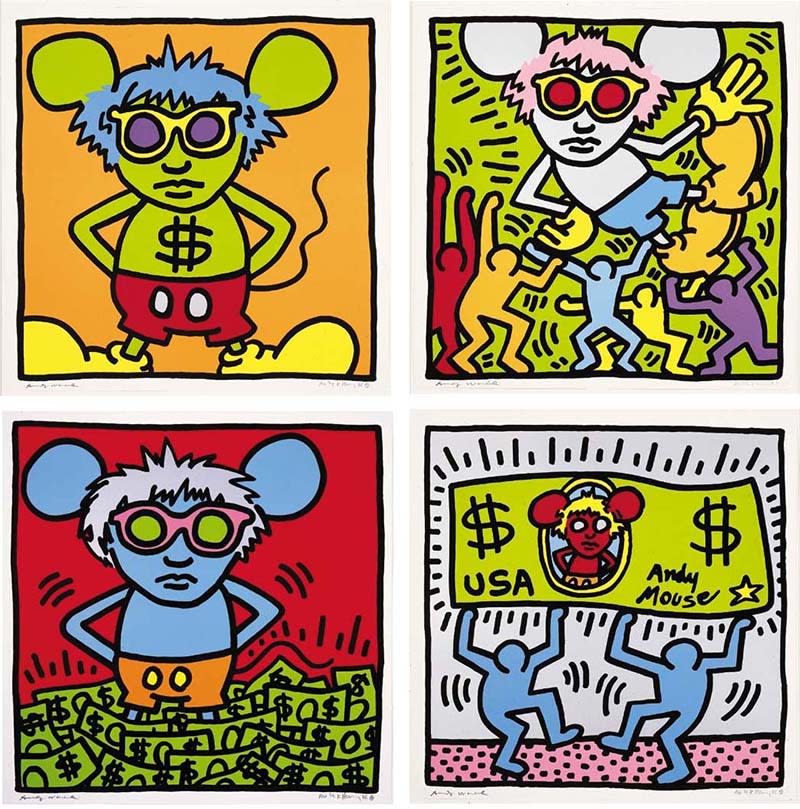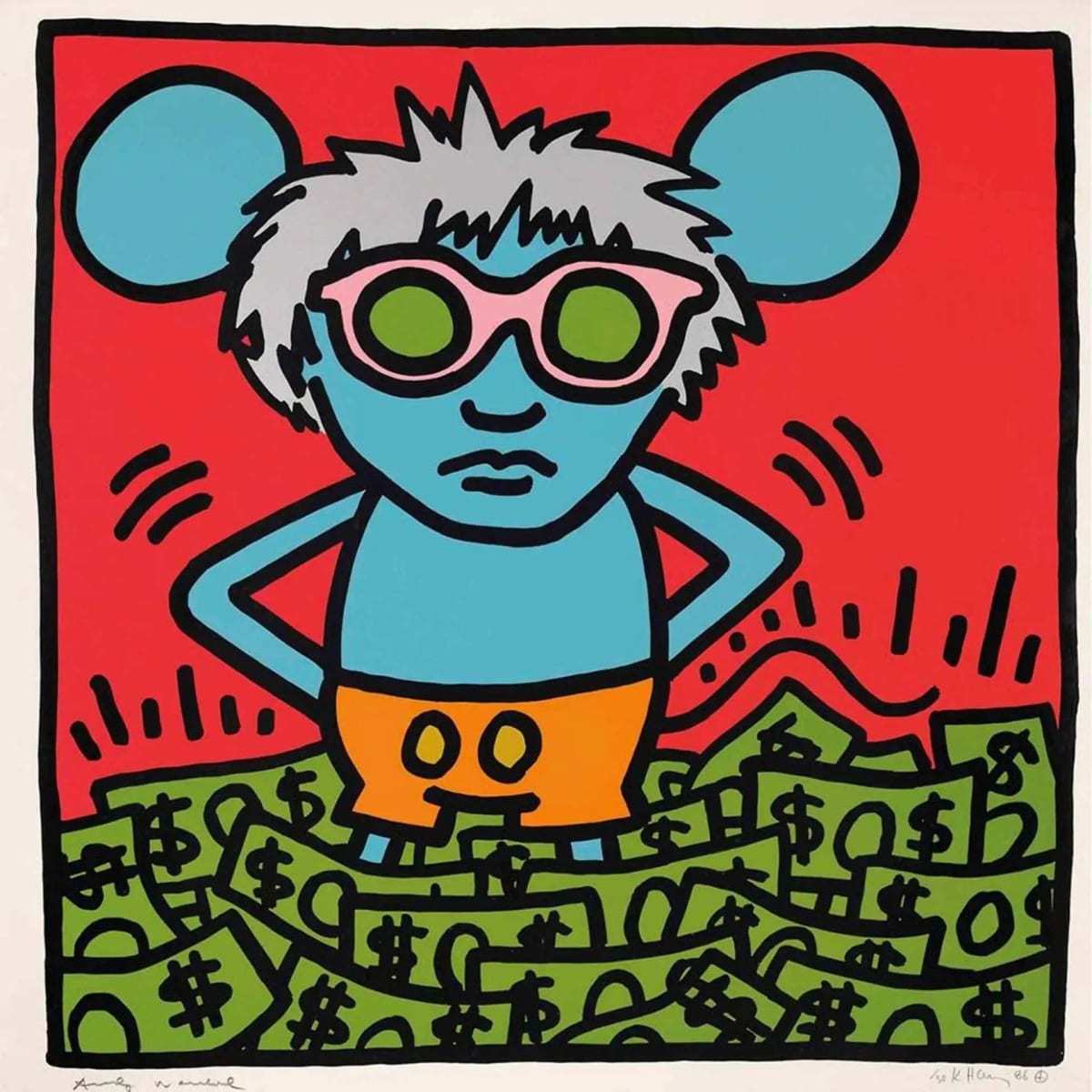
Under the Wing of Warhol
Andy Warhol had a significant history of mentorship, shaping the careers of many influential artists from the 1960s onward. At his studio, The Factory, he collaborated with and supported artists like Gerard Malanga and Isabelle Collin Dufresne, along with a group of bohemian and counterculture figures known as his superstars. This collective not only contributed to Warhol's projects but also played a central role in the creative output and social dynamics of The Factory. Warhol's history of mentorship demonstrated his commitment to fostering talent and pushing the boundaries of art through collaboration.
It's important to note that Warhol's mentorship wasn't a one-sided affair; he often benefited from these relationships. An iconic example is his partnership with the up-and-coming artist Jean-Michel Basquiat in the 1980s. Their collaboration was both a friendship and a creative exchange, resulting in over 150 jointly produced works. Warhol admired Basquiat's speed and originality, and their bond was both supportive and competitive, reflecting Warhol's constant quest for reinvention.

Warhol and Haring: Pioneers of Pop Art
Warhol played a pivotal role in the development and consolidation of the Pop Art movement during the 1960s. After a successful career as a commercial artist, he redefined popular culture with his art, challenging traditional art conventions by using everyday objects and iconic images like Marilyn Monroe's likeness and Campbell's Soup Cans. His experiments with silkscreening, performance art, filmmaking, and video installations blurred the lines between fine art and mainstream aesthetics. Warhol's revolutionary approach made art accessible and relatable to the masses, earning him the title of the "Father of Pop Art."
Haring's impact on Pop Art took a different path, characterised by spontaneity and a distinct street art style. He began with chalk drawings in New York City subways, showcasing iconic imagery such as the Radiant Baby, barking dogs, and flying saucers. Haring's bold lines and vibrant murals, often created in public spaces like hospitals and schools, carried powerful political and societal messages. His work gained recognition for its energetic lines and movements, as well as its activism, particularly in addressing homosexuality and AIDS awareness. Haring's rise to fame was grittier, reflective of the ethos of the 1980s.
Both artists pushed the boundaries of the art world by incorporating elements from everyday life and commenting on contemporary issues. Warhol's use of commercial goods and celebrity culture, along with Haring's street art aesthetics and activism, democratised art, making it more approachable for the general public. Their distinct contributions laid the foundation for subsequent generations of artists and the ongoing evolution of the Pop Art movement.

The Birth of a Pop and Street Art Alliance
According to Warhol's diaries, he first encountered Keith Haring during one of Haring's exhibitions at the Shafrazi Gallery in late 1982. At that time, Haring's career was just beginning, while Warhol was already an established giant in the art world. Impressed by the spontaneous dancing figures in Haring's art, Warhol visited Haring's studio, and a friendship emerged in 1983. The two often spent time together, and Warhol served as a mentor to Haring. Haring credited Warhol as a major influence and early supporter of his career, appreciating the endorsement and guidance he received.
Over the next five years, Warhol and Haring exchanged many works and featured each other in their art. Warhol found in Haring a kindred spirit and a source of rejuvenation for his own work, while Haring gained invaluable insights and support from Warhol. The creative fusion between Warhol's established pop artistry and Haring's emerging street art flair illustrates the adaptive and inclusive nature of the Pop Art movement through the lenses of two visionary figures.
The Pop Shop and "Andy Mouse"
In 1986, Haring opened the Pop Shop in downtown Manhattan, a radical venture reflecting his vision of art accessibility for all. The Pop Shop wasn't just a retail space; it embodied Haring's artistic philosophy, selling his work and merchandise at affordable prices to democratise art. The store offered a range of items, from collectibles to original art pieces, making Haring's vibrant and socially conscious art a part of everyday life.
Haring initially had reservations about the Pop Shop's concept, as it challenged the elitism of the art world. However, Warhol, ever the supporter of innovative ideas, believed in Haring's vision and even created a line of t-shirts to support the venture. In gratitude, Haring created the series "Andy Mouse," depicting Warhol as an iconic figure in the style of Mickey Mouse, a character Warhol had depicted several times. "Andy Mouse'' engaged with motifs present in Warhol's art, such as money and media, while questioning the factors driving cultural stardom. It also borrowed from Warhol's own silk screening technique, cementing the homage.
The legacy of the "Andy Mouse" series and the Pop Shop is profound, challenging the elitism of the art world and proving that art could be commercial while maintaining integrity. This approach influenced not only the art sector but also retail, changing how people consumed, appreciated, and distributed art.

Warhol's Passing
In February 1987, Warhol passed away unexpectedly following complications from gallbladder surgery. Haring expressed deep reflection on Warhol's life and career in his diaries, revealing how profoundly the news affected him. He drew parallels between Warhol's death and the social gatherings they attended together, highlighting Warhol's impeccable sense of timing. Warhol's exits from parties were discreet, ensuring the festivities continued, much like his exit from life left an inexplicable void. Haring's diary entries encapsulated the loss and impact of a remarkable friendship.
Legacy
The joint legacy of Warhol and Haring within the Pop Art movement is a testament to their transformative impact on art and culture. Their friendship was iconic, with Warhol recognizing Haring's talent and Haring revering Warhol's trailblazing persona, creating a powerful creative synergy. Together, they hosted events and supported each other on projects that left an indelible mark on the art world.
Explore our collection of Original Andy Warhol prints for sale or contact Andipa Editions via sales@andipa.com or call +44 (0)20 7589 2371 to buy Keith Haring original prints.
